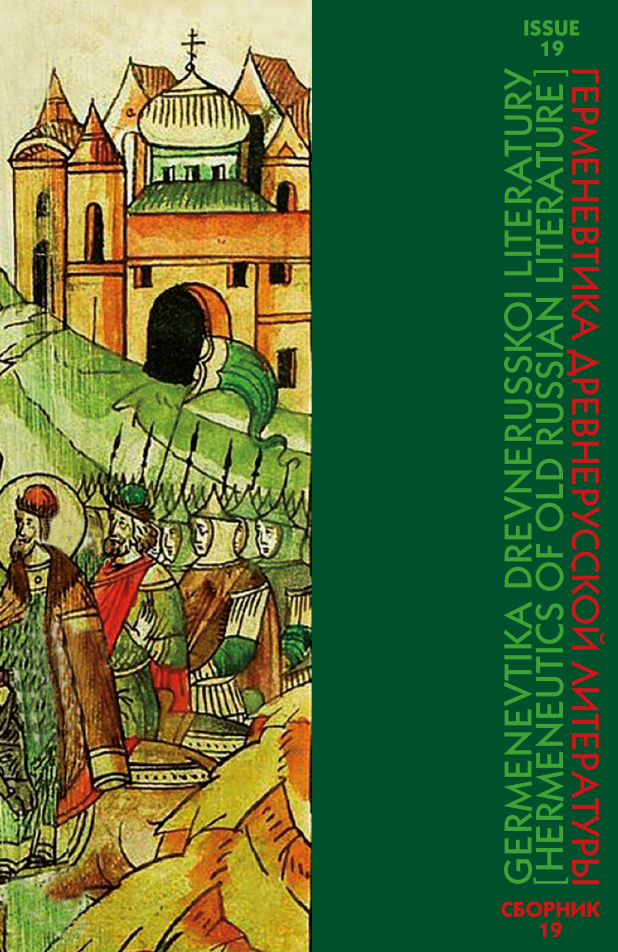Abstract
The article examines the reception of amous chronicle plot on the single combat of the Old Russian Prince Mstislav and the Kasozhsky Prince Rededya in the late literary tradition. It is interesting to trace the authors’ attitude to the image of enemy (alien) and characteristics of the heroes of confrontation. The old plot became attractive as it made it possible to comprehend and rethink the concepts of friend and alien, hero and enemy. The imagological perception of Rededya reflected the attitude towards the enemy in different epochs. The most negative image of enemy appears in the text of the Power Book of the Royal Genealogy, compiled in the era of victory over the Horde and the centralization of power in the hands of Moscow branch of princes. The image of Rededya is created in accordance with the biblical (the combat between David and Goliath) and Old Russian (the era of the Horde yoke) traditions, in the text he is not just a man, an enemy, but the embodiment of mortal sin, pride. Later texts refuse to dehumanize the enemy, turning him into a symbol of evil, but present him as a warrior, an opponent, a defeated one, at the same time religious motives and the perception of Mstislav’s victory as a miracle gradually disappear from the texts. Interest is shifting from the image of enemy to the image of prince Mstislav, who is now deprived of idealization, although he remains a generally positive character.
REFERENCES
1 Bondi, S.M. “Kommentarii: A.S. Pushkin. Mstislav” [“Commentaries: A.S. Pushkin. Mstislav”]. Pushkin, A.S. Sobranie sochinenii: v 10 t. [Collected Works: in 10 vols.], vol. 3. Available at: https://rvb.ru/pushkin/02comm/0809.htm (Accessed 22 July 2023). (In Russian)
2 Gadlo, A.V. “K istorii Tmutarakanskogo kniazhestva vo vtoroi polovine XI v.” [“On the History of the Tmutarakan Principality in the 2nd Half of the 11th Century”]. Slaviano-russkie drevnosti. Istoriko-arkheologicheskoe izuchenie Drevnei Rusi: sbornik statei [Slavic-Russian Antiquities. Historical and Archaeological Study of Ancient Rus’: Collection of Articles], iss. 1. Leningrad, Leningrad State University Publ., 1988, p. 202. (In Russian)
3 Dzamikhov, K.F. “Rannie letopisnye siuzhety o kasogakh i fol’klor” [“Early Chronicle Stories about the Kasogs and Folklore”]. Dzamikhov, K.F. Adygi: vekhi istorii [Adygs: Milestones of History]. Nalchik, El’brus Publ., 2008, pp. 7–14. (In Russian)
4 Dolgov, V.V. “Poedinki v drevnerusskoi voinskoi kul’ture” [“Duels in Old Russian Military Culture”]. Voenno-istoricheskii zhurnal, no. 6, 2014, pp. 57–60. (In Russian)
5 Kovaleva, T.I., and I.E. Loshchilov. “Victor Sosnora`s Poem ‘1111:’ from Old Russian Tradition to Avant-garde.” Germenevtika drevnerusskoi literatury [Hermeneutics of Old Russian Literature]. Issue 22. Ed.-in-chief O.A. Tufanova. Moscow, IWL RAS Publ., 2023, pp. 581–599 https://doi.org/10.22455/HORL.1607-6192-2023-22-581-599 (In Russian)
6 Kolesov, V.V. Mir cheloveka srednevekovoi Rusi [World of Man in Medieval Rus’]. Moscow, Akademicheskii proekt Publ., 2019. 659 p. (In Russian)
7 Kukulin, I. “‘Tuda, gde net Ia…’: Viktor Sosnora i evoliutsiia russkoi poezii vtoroi poloviny XX veka” [“‘There, Where is no I…’: Victor Sosnora and the Evolution of Russian Poetry of the Second Half of the 20th Century”]. Novoe literaturnoe obozrenie, no. 6, 2019. Available at: https://magazines.gorky.media/nlo/2019/6/ tuda-gde-net-ya-viktor-sosnora-i-evolyucziya-russkoj-poezii-vtoroj-poloviny-xx-veka.html (Accessed 7 May 2023). (In Russian)
8 Loshchilov, I.E., and T.I. Kovaleva. “ʽMstislava drevnii poedinok…’: rasskaz ʽPovesti vremennykh let’ v stikhotvorenii V. Sosnory ʽBoi Mstislava s Rededei’ (1959)” [“ʽThe Ancient Duel of Mstislav…’: The Story of ʽThe Russian Primary Chronicle’ in a V. Sosnora’s Poem ‘The Battle of Mstislav with Rededya’ (1959)”]. Sibirskii filologicheskii zhurnal, no. 2, 2023, pp. 166–179. DOI: 10.17223/18137083/83/13 (In Russian)
9 Sapunkov, A.A. “Genezis kulachnogo boia kak elementa pravovoi kul’tury drevnego, antichnogo i srednevekovogo obshchestva: istoriko-pravovoe issledovanie” [“History of Fistfighting as an Element of Legal Culture of Ancient, Antique and Medieval Society: Historical and Legal Research”]. Psikhopedagogika v pravookhranitel’nykh organakh, vol. 26, no. 2 (85), 2021, pp. 226–233. DOI: 10.24412/1999-6241-2021-2-226-233 (In Russian)
10 Trofimova, N.V. “Epicheskii siuzhet edinoborstva v drevnerusskikh pamiatnikakh” [“The Epic Plot of Single Combat in Ancient Russian Texts”]. Abasheva, D.V., ed. Semantika narodnoi kul’tury v literature: Materialy mezhvuzovskoi mezhdistsiplinarnoi nauchnoi konferentsii s mezhdunarodnym uchastiem. Moskva, 21–22 oktiabria 2021 g. [Semantics of Folk Culture in Literature: Proceedings of the Interuniversity Interdisciplinary Scientific Conference with International Participation. Moscow, October 21–22, 2021]. Moscow, Moscow State Pedagogical University Publ., 2022, pp. 79–85. (In Russian)
11 Tsygankov, S.A. “Poedinok Mstislava s Rededei i ego otrazhenie v fol’klore” [“The Duel Between Mstislav and Rededya and Its Reflection in Folklore”]. Vestnik Sankt-Peterburgskogo universiteta, iss. 4, part 1, 2008, pp. 3–9. (In Russian)
12 Sheudzhen, E.A. “N.M. Karamzin o pervykh kontaktakh narodov Rusi i Severnogo Kavkaza” [“N.M. Karamzin on the First Contacts of the People of Rus’ and the North Caucasus”]. Nauchnaia mysl’ Kavkaza, no. 1, 2013, pp. 77–83. (In Russian)
13 Sakhno, Serguei. “L’image de l’ennemi à travers les termes de différentes langues (données de sémantique historique).” Krulic, Brigitte, éditeur. L’ennemi en regard(s). Images, usages et interprétations dans l’histoire et la littérature (France, Allemagne, Russie, XVIII–XX siècles). Berne etc., P. Lang, 2012, pp. 13–30. (In French)






